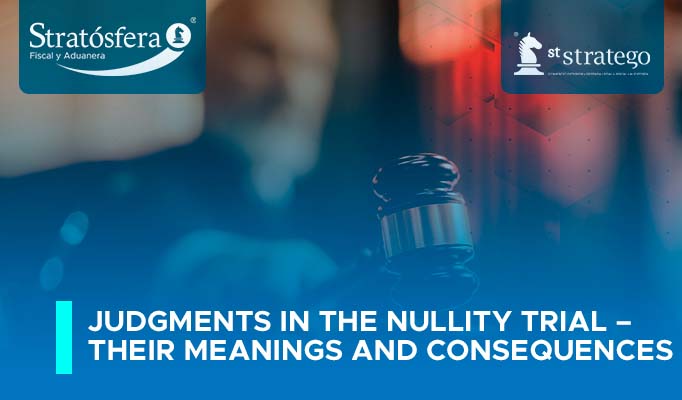The Nullity Trial is the ideal means of defense through which a taxpayer can challenge the legality of the acts or resolutions issued by Tax Authorities that are considered to have violated the legal provisions and also created a prejudice in the rights of the taxpayer.
Although this trial is suitable to combat the arbitrariness with which the tax authorities act through their administrative acts, the truth is that the strategy and arguments that must be raised in the reference trial at the time of initiating a litigation against the federal treasury should not go unnoticed.
The foregoing since the problem and its possible solution of each particular matter must be identified, this given that in this Trial, the Court may issue judgments in different directions, three to be specific, which are based on article 52 of the Federal Law of Contentious Administrative Procedure and which consist of the following:
- Declare the Contested Act null and void,
- Declare a Nullity for Effects, and;
- Recognize the Validity of the Contested Act.
However, for a better understanding of the subject, it is worth mentioning that a judgment is a judicial resolution by means of which a Judge resolves disputes according to the approaches of each of the parties. In this, an analysis is made with respect to the facts and arguments raised, which are studied to capture the foundations and reasons that served to resolve the litis.
Now, in most cases of the Nullity Trial, if not in all, it is sought to obtain a judgment that declares the Plain and Simple Nullity, and this is because in most of the acts that are challenged, they are resolutions that impose tax credits, so the most appropriate effect for this type of acts will always be their total nullity, because in this way the Court as it is the Federal Court of Administrative Justice (TFJA) may determine the ineffectiveness or illegality with which the contested resolution was issued when it is noticed that it lacks elements of validity for its legal existence, so that when obtaining this judgment, the administrative act is annulled and ceases to have legal life.
In addition to the above, when there are assets that were illegally seized or it is noticed that an undue payment was made to the federal treasury, at the time of challenging its resolution from which these affectations derive, you will have to request a return of the goods, economic compensation or payment of the undue depending on the case. Thus, in addition to a Plain and Simple Nullity, it will be possible to obtain a request from the TFJA in which it may order the Competent Authority to subtract your property or rights affected, which must be carried out in a mandatory manner by the defendant authority.
On the other hand, we have the Judgments that declare a Nullity for Effects, which are issued when the Judge notices any omission in the formal requirements required by law, as well as violations of the procedure that would have affected the defenses of the taxpayer.
The aforementioned Nullity for Effects is not entirely favorable, since the effects imply that the defendant Authority can correct the deficiencies detected in the contested decision, so the TFJA orders the procedure to be replaced based on the irregularity detected in accordance with the grievances expressed by the plaintiff.
So, what happens in these cases is that the judgments for effects can give partially good results, since, although it could be obtained that errors are corrected both in the procedure and in the imposition of the administrative sanctions determined incorrectly, the truth is that there would still be an act of annoyance when the defendant Authority reissues that other resolution with the irregularities remedied, having the opportunity to fight this resolution again, but it is more difficult to obtain a favorable result and considerably lengthening the time that will be in dispute with the tax authority.
Finally, we have the judgments that recognize the validity, this type of judgments are those that definitely disadvantage the taxpayer, because as its name indicates, it recognizes the validity with which the contested act was issued; that is, the Judge considers that said act was issued within the parameters allowed by the Law, as estimated by the Tax Authority.
As you can see, each of the judgments has different characteristics and it is necessary that at the time of initiating a Nullity Trial the concepts of challenge poured into the initial lawsuit are tending to obtain a Plain and Simple Nullity, since with this, the consequences or legal obligations that had arisen with the act when obtaining the nullity of the same would die, for example, administrative penalties such as tax credits, fines and disqualifications.
If an adequate defense is not considered in the Nullity Trial, an unfavorable resolution could be obtained, which although it could be the subject of subsequent means of defense, this harms the taxpayer before the extension of the deadlines and possible expenses in which he has to incur. A Nullity Trial on average can last between 6 months and 1 year, so it is evident that in the first instance it is advisable to obtain a sentence that determines a Plain and Simple Nullity so as not to extend the controversial a year or more depending on the situations.
As an informative fact, it is worth mentioning that only for the period between November 2020 and October 2021, the Federal Court of Administrative Justice admitted 168,398 lawsuits and issued 174,922 final judgments, of which only 7,520 were revoked by means of defense raised before the Courts of the Judicial Power, this in accordance with the information published in bulletin 50/2021, dated December 10, 2021 from the official website of the TFJA.
Based on the above, it is evident that any dispute raised before the TFJA must be correctly formulated to obtain from the beginning a Plain and Smooth Nullity, since the effectiveness of subsequent means of defense such as direct amparo has a lower effectiveness rate, as can be seen in the data presented where it is noted that only 7,520 sentences were revoked, the equivalent of 4% of the total final judgments issued.
For the above reasons, it is recommended that any taxpayer who is facing an act or administrative resolution that causes effects to their legal sphere, go before the specialists in the field to raise and execute the appropriate means of defense in order to obtain the most favorable result in an adequate period of time.
This document does not constitute a particular consultation, and therefore, Asesores Stratego SC, is not responsible for the interpretation or application given to it. The total or partial reproduction of this publication, by any means or procedure, is prohibited without the prior, express and written authorization of the author. Any form of unauthorized use will be prosecuted in accordance with the provisions of the Federal Copyright Law. We are at your service to answer your questions or comments, for more information on this subject and our services, please contact us at: info@asesores-stratego.com
or application given to it. The total or partial reproduction of this publication, by any means or procedure, is prohibited without the prior, express and written authorization of the author. Any form of unauthorized use will be prosecuted in accordance with the provisions of the Federal Copyright Law. We are at your service to answer your questions or comments, for more information on this subject and our services, please contact us at: info@asesores-stratego.com




